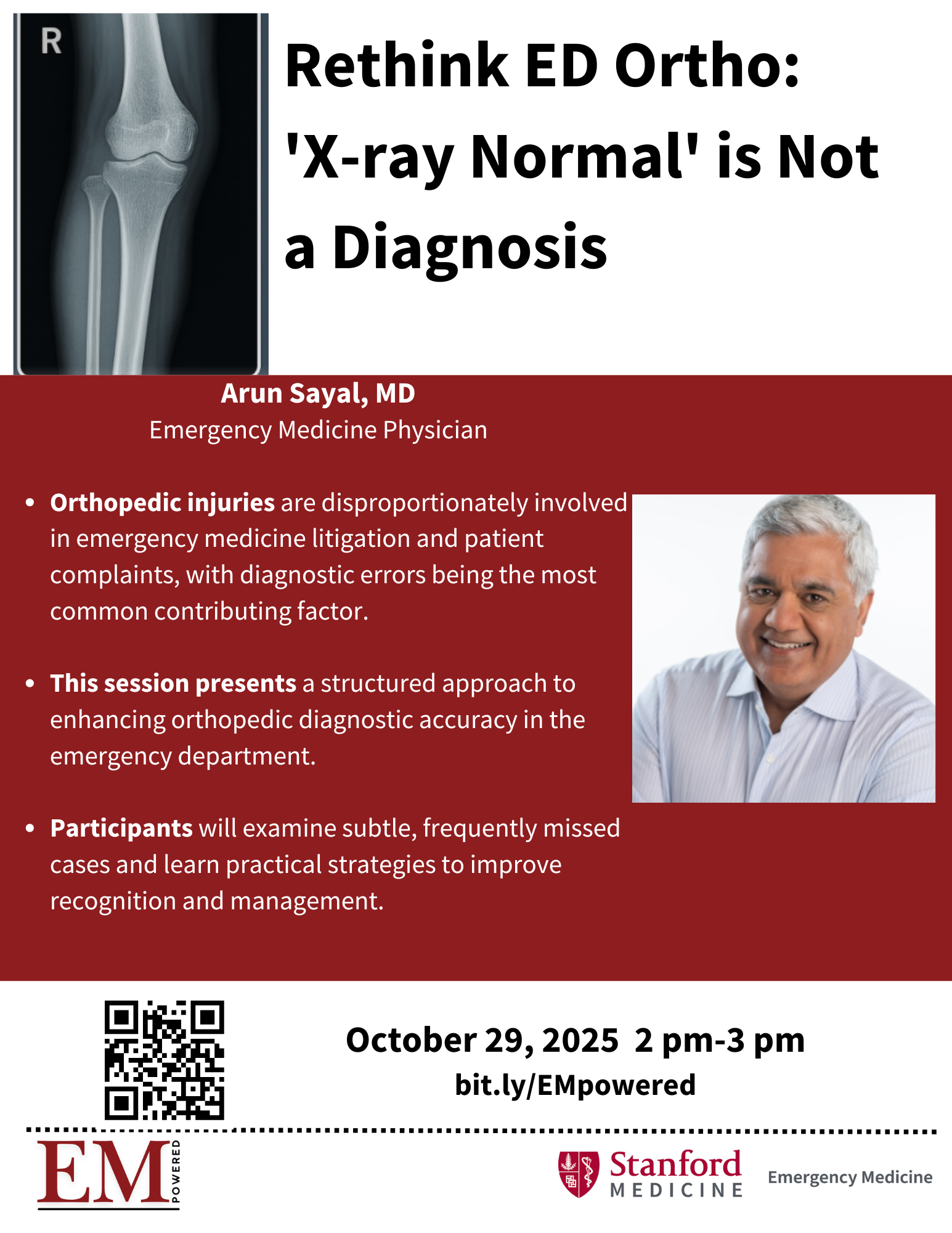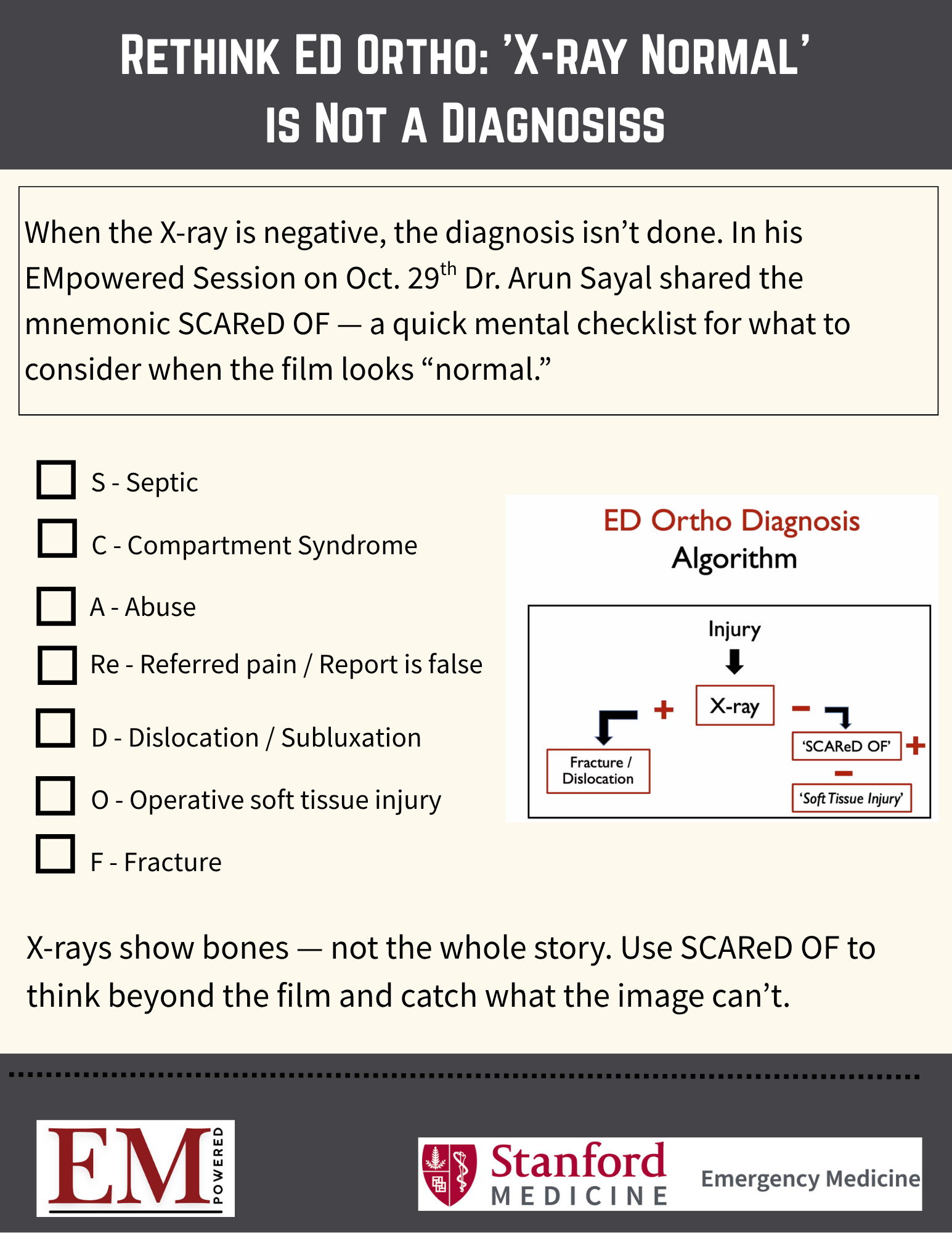
Welcome to EMpowered: Faculty Development Reimagined
EMpowered is Stanford Emergency Medicine’s transformative faculty development program, designed to inspire excellence and growth across every aspect of your career. Through a dynamic blend of opportunities, EMpowered equips you with the tools, knowledge, and support to thrive in today’s rapidly evolving medical landscape.
The program has seven focus areas, each crafted to enhance your professional journey:
Practice Essentials: Build on foundational knowledge while mastering the latest advancements in medical practice
Leadership & Management: Refine the skills to effectively guide teams of all sizes and drive meaningful change.
Teaching & Medical Education: Elevate your teaching strategies and innovate medical education for lasting impact.
Beyond the Badge: Unlock the full spectrum of Stanford’s perks and benefits to enrich your life.
Frontiers of EM: Explore cutting-edge innovations, precision medicine, and the next frontiers of Emergency Medicine.
Research & Scholarship: Drive discovery and contribute to the advancement of medical knowledge
Wellness: Prioritize well-being to cultivate resilience and inspire balance in your personal and professional life.
Whether you’re mastering the essentials, exploring emerging trends, or unlocking the unique perks of life at Stanford, EMpowered offers a tailored pathway for every faculty member. Together, we’ll cultivate a culture of learning, leadership, and wellness—empowering you to make a greater impact in Emergency Medicine and beyond.
Join us on this journey of growth and excellence. This is EMpowered.
Upcoming Events
October 29, 2025
2:00 PM - 3:00 PM
Rethink ED Ortho: ‘X-ray Normal’ is Not a Diagnosis
Orthopedic injuries are a leading source of emergency medicine lawsuits—and misdiagnoses are often to blame. This lecture offers a practical way to rethink ED orthopedics, with subtle case reviews, a better diagnostic strategy, and a memorable mnemonic for “normal” MSK x-rays. Improve your accuracy on your next shift!
In Case You Missed It…
Recent Lecture/Slides
Stanford EM MD First Dose
-
Pharmacy Geniuses at Your Service
What do you want to know? Submit your question here
First Dose: EM Pharmacy Insights
Start each month with a shot of pharmacy wisdom.
Nov
We have seen different dosing on patients' charts for treating acute otitis media and Strep pharyngitis, so this month's first dose is refilling your knowledge bank with treatment for both, including renal dosing.
TL;DR:
1. Bacterial resistance at SHC means high dose amoxicillin or Augmentin should be first line therapy for AOM.
2. First line therapy for positive Strep test remains penicillin or amoxicillin.Stay tuned! There will be a PRN dose in the next few days. Just in time for sick season
Oct
TL;DR:
1. IV magnesium sulfate (4 grams over 40 minutes) may be useful as an adjunct therapy in addition to standard rate control (e.g. metoprolol, diltiazem) for AF with RVR.
2. Flushing was the primary adverse effect reported in this study, although rapid administration can also cause transient hypotensionSept
Aug
TL;DR:
1 Almost all antibiotics require adjustment for impaired renal function. Exceptions: Ceftriaxone, azithromycin, doxycycline, linezolid, clindamycin, nafcillin.
2 Creatinine Clearance (rather than GFR) is still used to determine the need for dose adjustment for most medications. In general, estimated Creatinine Clearance < 60 mL/min is a good cutoff to start considering dose adjustment (exact cutoffs vary depending on specific agent).
3 Consult SHC’s Antimicrobial Dosing Guide (or your ED pharmacist) for drug-specific dosing recommendations.
July
TL;DR:
1. Metronidazole 500 mg Q12H is preferred over Q8H for most intra-abdominal infections to decrease pill burden and to minimize side effects.
2. C. difficile infections that are being treated with metronidazole should continue utilizing 500 mg Q8H dosing (Note: metronidazole is NOT first line)
3. H. pylori treatment should utilize 500 mg Q6-8H due to resistance
June
TL;DR:
1 Prochlorperazine was shown to be more effective for relieving migraine headache than metoclopramide when both are dosed at 10 mg IV
2 Diphenhydramine prevented akathisia when metoclopramide 20 mg IV or prochlorperazine 10 mg IV was administered for acute migraines
3 Diphenhydramine should NOT be given to prevent akathisia with metoclopramide 10 mg IV due to lack of proven clinical efficacy
May
GLP-1 agonists and the side effects you might see
TL;DR:
1 Understanding the common side effects of GLP-1 agonists and their risk factors is necessary as the number of patients taking them increase.
2 The most common side effects are the GI side effects, many of which will dissipate after the first couple of months of treatment or by decreasing the dose.
3 Half-lives vary from hours to over a week for the different agents and formulations.
April
Uncomplicated UTI (uUTI) Updates
TL;DR:
1 IDSA has updated the definition for uUTI. The same antibiotics and duration should be used in men and in women.
2 Nitrofurantoin is the preferred agent for uUTI. Alternatively, consider prescribing cephalexin 500 mg BID instead of QID.
You can find links to archived lectures/slides in the focus area tool box
EMpowered Focus Area Tool Box
Build on foundational knowledge while mastering the latest advancements in medical practice.
-
Spotlight
Sign up for one-on-one sessions with Dr. Eubee Koo in Ophthalmology to learn how to use the slit lamp in the ED. Don't miss this opportunity to enhance your skills and knowledge!
1. Practice Essentials Recordings (If available)
Learner Assessment in EM Best Practices, Questions, and Controversies
E(ye)M for EM: “Do-not-misses” & Initial Management for Eyes in the ED
2. Faculty Procedure Skills Training Prep (Ultrasound-Guided)
3. Critical Care Lectures
January 3
No session, holiday break
February 7
March 6
April 3
Using Generative AI in Clinical Care, Erkin Otles, University of Michigan
May 1
June 5
July 3
August 7
September 4
Cases in Critical Care Medicine – Hemorrhagic Shock, Dr. Natalie Htet
October 2
Cases in Critical Care Medicine – LV Failure, Dr. Hallie St. John Brown
November 6
Cases in Critical Care Medicine – Hypercapnic Respiratory Failure, Dr. Yoshi Mitarai
December 4
Cases in Critical Care Medicine – Submassive PE, Dr. June Go
The Place for All Your Focus Area Resources
Refine the skills to effectively guide teams of all sizes and drive meaningful change.
-
1 Leadership & Management Lectures (as available)
2 Leadership Programs
Explore cutting-edge innovations, precision medicine, and the next frontiers of Emergency Medicine.
-
1 Frontiers of EM Lectures (as available)
5/21/2025 EMR Proficiency: Understanding Dashboards, Billing, and Trainee Coordination
2/26/25 Smart Charting: Efficiency, Accuracy & Workflow Hacks in the ED
Drive discovery and contribute to the advancement of medical knowledge.
-
Research/Scholarship Lectures(as available)
Unlock the full spectrum of Stanford’s perks and benefits to enrich your life.
Prioritize well-being to cultivate resilience and inspire balance in your personal and professional life.
-
Wellness Lectures (as available)
Looking for some free counseling support covered by Stanford’s Aetna plan?
Elevate your teaching strategies and innovate medical education for lasting impact.
-
1 Please join us for our Medical Education Conference.
Organizing Your Chaos: A Blueprint for Building Your Educator Portfolio
AI in Your Research Toolkit: Practical Applications for Medical Educators
Join Here, Tuesday mornings, 10-11am.
Medical Education WIP to follow 11-12p.
Interested in WIPing? Contact Holly Caretta-Weyer to sign up.
SPOTLIGHT
What would you like to hear about through EMpowered?
Your Support Team
-

Jennifer Kanapicki, MD
Director of Faculty Development
-

Jeanette Conley
Education Administrative Associate




















